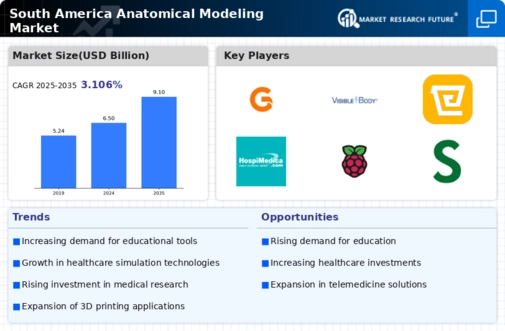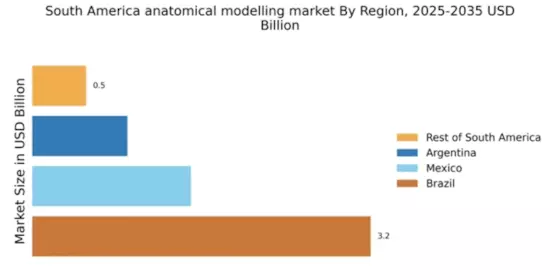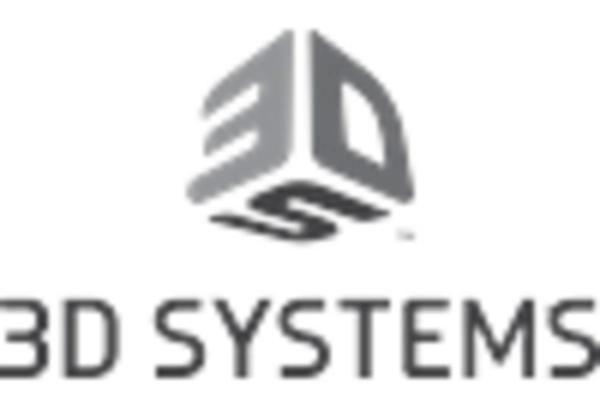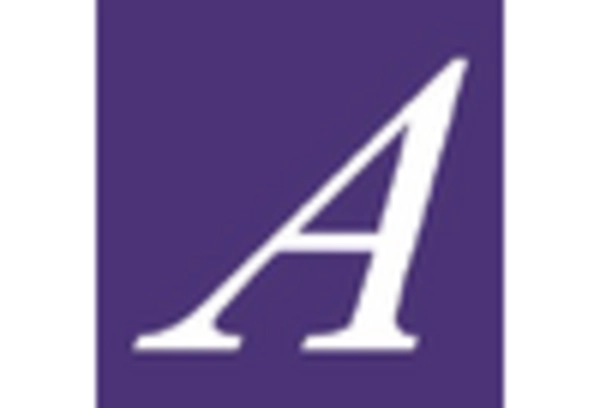Increased Healthcare Expenditure
Healthcare expenditure in South America has been on an upward trajectory, which significantly impacts the anatomical modelling market. Governments and private sectors are investing more in healthcare infrastructure, with total spending projected to reach $200 billion by 2026. This increase in funding is likely to enhance the availability of advanced medical training tools, including anatomical models. As healthcare providers recognize the importance of effective training and education, the anatomical modelling market stands to gain from this trend. Enhanced training tools are essential for improving surgical outcomes and patient care, leading to a greater demand for high-quality anatomical models. Additionally, the rising prevalence of chronic diseases necessitates better training for healthcare professionals, further driving the need for sophisticated anatomical modelling solutions in the region.
Focus on Research and Development
Research and development (R&D) initiatives in South America are significantly influencing the anatomical modelling market. With an increasing number of universities and research institutions prioritizing anatomical research, there is a growing need for advanced modelling solutions. The anatomical modelling market is likely to benefit from this focus on R&D, as researchers require precise and detailed anatomical models for their studies. Investment in R&D is projected to increase by 15% annually, indicating a robust commitment to advancing medical knowledge. This trend not only fosters innovation within the anatomical modelling market but also encourages collaboration between academia and industry, leading to the development of cutting-edge modelling technologies. As research efforts expand, the demand for high-quality anatomical models is expected to rise, further propelling the growth of the market.
Rising Demand for Medical Education
The anatomical modelling market in South America experiences a notable surge in demand driven by the increasing emphasis on medical education. Educational institutions are increasingly adopting advanced anatomical models to enhance the learning experience for medical students. This trend is reflected in the growing investment in educational resources, with institutions allocating approximately $500 million annually towards innovative teaching tools. The anatomical modelling market is poised to benefit from this shift, as educators seek to provide students with realistic and interactive learning experiences. Furthermore, the integration of 3D printing technology in educational settings allows for the customization of anatomical models, catering to specific curriculum needs. This adaptability not only enriches the educational process but also fosters a deeper understanding of human anatomy among students, thereby propelling the growth of the anatomical modelling market in the region.
Growing Interest in Surgical Simulation
The anatomical modelling market in South America is witnessing a growing interest in surgical simulation, which is reshaping the landscape of medical training. As surgical procedures become increasingly complex, the need for realistic training tools has never been more critical. The anatomical modelling market is responding to this demand by providing high-fidelity models that replicate human anatomy accurately. This trend is supported by a projected growth in the surgical simulation market, which is expected to reach $1 billion by 2027. The ability to practice surgical techniques on realistic models allows healthcare professionals to refine their skills without risking patient safety. Consequently, the anatomical modelling market is likely to thrive as more institutions adopt these simulation tools to enhance surgical training and improve patient outcomes.
Technological Integration in Healthcare
The integration of technology in healthcare practices is transforming the anatomical modelling market in South America. Innovations such as augmented reality (AR) and virtual reality (VR) are being increasingly utilized to create immersive anatomical models that enhance the learning and training experience. The anatomical modelling market is likely to see a substantial increase in demand for these high-tech solutions, as they provide a more interactive and engaging way to study human anatomy. With the potential to reduce training time and improve retention rates among medical professionals, these technologies are becoming essential tools in medical education. As healthcare institutions invest in these advanced technologies, the anatomical modelling market is expected to expand, catering to the evolving needs of the medical community in South America.


















Leave a Comment